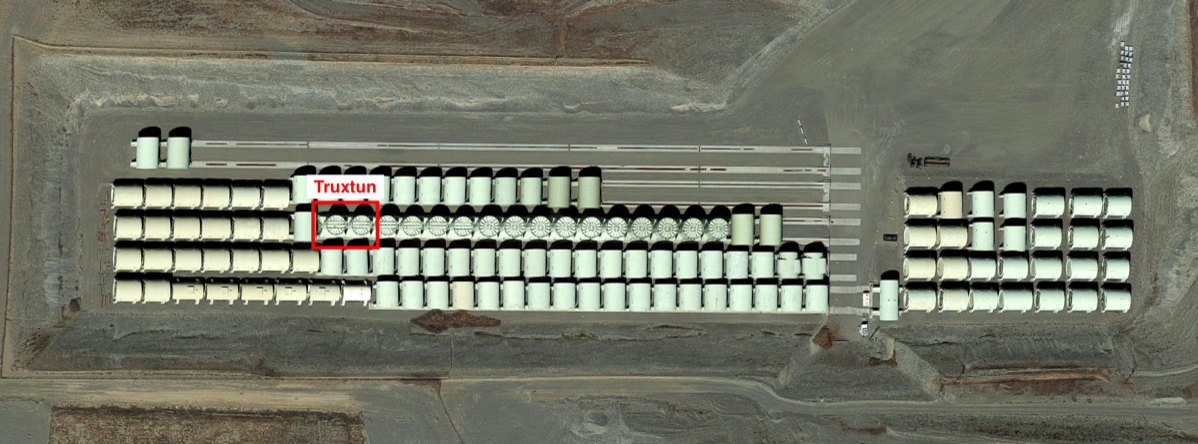USS Truxtun DLGN-35 and CGN-35
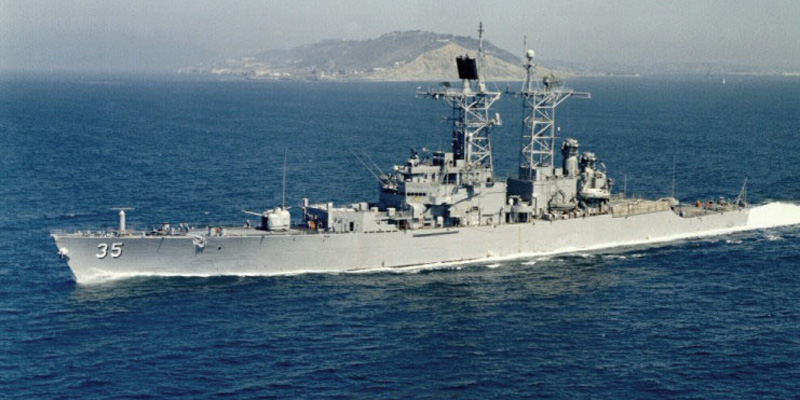
General Characteristics
Keel laid: June 17, 1963
Launched: December 19, 1964
Christened: December 19, 1964
Commissioned: May 27, 1967
Decommissioned: September 11, 1995
Builder: NY Shipbuilding Corp., Camden, NJ
Propulsion System: two D2G GE reactors
Propellers: two
Length: 564 feet (172 meters)
Beam: 57,7 feet (17.6 meters)
Draft: 30,8 feet (9.4 meters)
Displacement: approx. 9,150 tons full load
Speed: 30+ knots
Aircraft: one SH-2 Seasprite (LAMPS) helicopter
Crew: 37 Officers, 530 Enlisted
Length: 564 feet (172 meters)
Beam: 57,7 feet (17.6 meters)
Draft: 30,8 feet (9.4 meters)
Displacement: approx. 9,150 tons full load
Speed: 30+ knots
Aircraft: one SH-2 Seasprite (LAMPS) helicopter
Crew: 37 Officers, 530 Enlisted
Armament: two Mk-141 Harpoon missile launchers, Mk-46 torpedoes, one Mk-42 5-inch/54 caliber lightweight gun, two 20mm Phalanx (CIWS), four machine guns, one Mk-10 Mod. 8 missile launcher for Standard missiles (ER) and ASROC
Combat Systems: SPS-48 3D Air Search Radar, SPS-40 Air Search Radar, SPS-67 Surface Search Radar, SQQ-26 Sonar, (1) Mk 14 Weapon Direction System, (4) Mk 76 Missile Fire Control Systems, (1) Mk 86 Gun Fire Control System, (1) Mk 114 ASW Fire Control System, (2) SPG-55 Radars, SLQ-25 Nixie, SLQ-32 EW System
Combat Systems: SPS-48 3D Air Search Radar, SPS-40 Air Search Radar, SPS-67 Surface Search Radar, SQQ-26 Sonar, (1) Mk 14 Weapon Direction System, (4) Mk 76 Missile Fire Control Systems, (1) Mk 86 Gun Fire Control System, (1) Mk 114 ASW Fire Control System, (2) SPG-55 Radars, SLQ-25 Nixie, SLQ-32 EW System
Insignia
The meaning behind the elements of the insignia:
- The crossed cutlass and missile allude to the ships named Truxtun spanning time from the days of sail and cutlass to those of nuclear propulsion and supersonic missiles.
- The five electrons orbiting the globe, to the five Truxtuns that were part of the U.S. Navy.
- The single star symbolizes the rank of Commodore Truxtun.
- The motto, expresses the standards and achievement of Thomas Truxtun:
Seamanship - Loyalty - Command
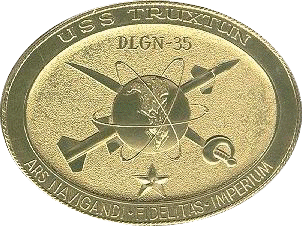
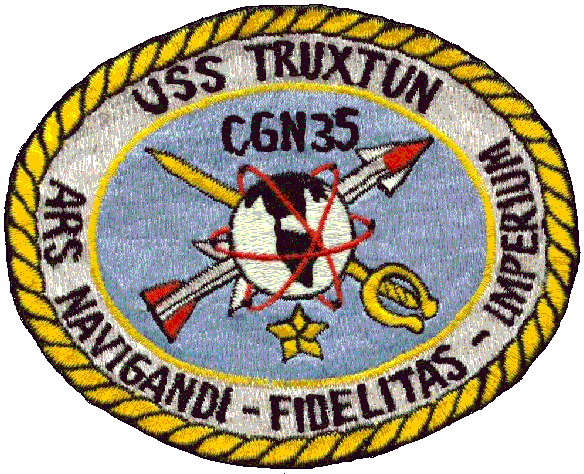
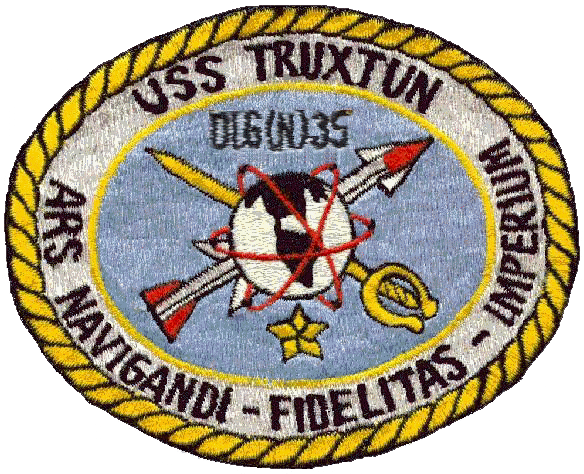
Truxtun Video
Truxtun Model
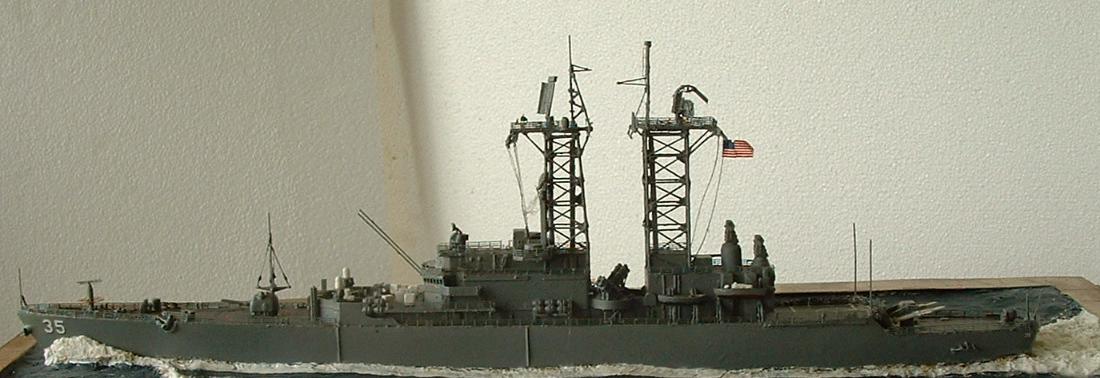
USS Truxtun DLGN/CGN-35 model constructed by a fellow crewman, Ken Mackenzie. Resin hull and photo etch metal parts, 1/350 scale kit available from Iron Shipwright HERE.
History
The keel for USS TRUXTUN (DLGN-35) was laid 17 June 1963 at New York Shipbuilding Corporation, Camden, New Jersey. USS TRUXTUN was christened on 19 December 1964 by Commodore Truxtun's great-granddaughter, Mrs. Kirby H. Tappan, and her niece, Mrs. Scott Umsted. VADM Hyman G. Rickover and California Congressman Chet Holifield were also in attendance. On 27 May 1967 USS TRUXTUN was commissioned as the nation's fourth nuclear-powered surface ship following USS BAINBRIDGE (CGN-25), USS LONG BEACH (CGN-9) and USS ENTERPRISE (CVN-65).
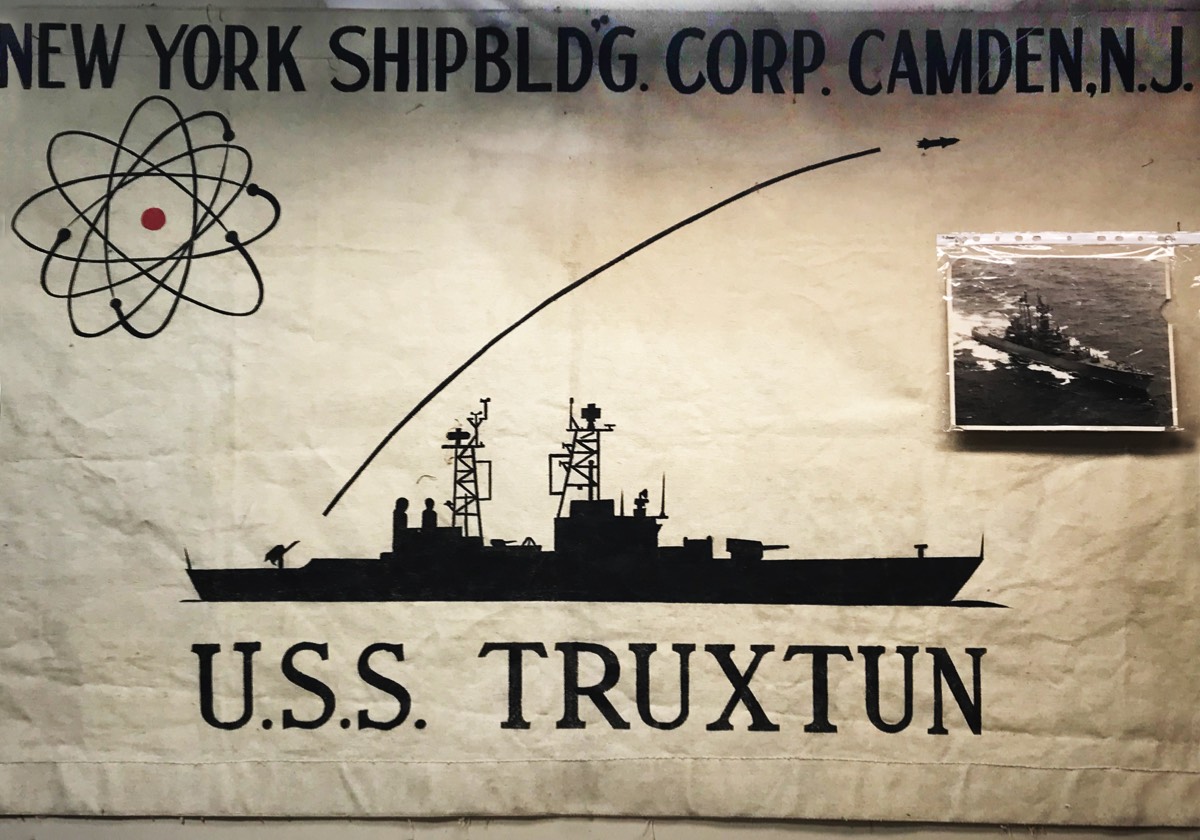
Shipyard Banner
Shortly after commissioning, USS TRUXTUN departed Camden, New Jersey on 3 June 1967 for her maiden transit to the West Coast and her new homeport of Long Beach and later to San Diego, California. TRUXTUN's voyage around Cape Horn included port visits to Rio de Janeiro, Brazil, Mar de Plata, Argentina, Valparaiso, Chile and Mazatlan, Mexico.
From January 1968 to August 1973 USS TRUXTUN made four Western Pacific deployments. TRUXTUN was one of the first ships to respond to the USS PUEBLO emergency. TRUXTUN served primarily as PIRAZ (Positive Identification Radar Advisory Zone) for Task Force 77 in the Gulf of Tonkin. TRUXTUN was tasked to ensure safety and flight tracking services for U.S. strike aircraft as well as maintain constant radar surveillance of the area providing air defense against enemy aircraft during LINEBACKER II operations. In 1969 USS TRUXTUN was awarded the Navy Unit Commendation for superior performance while operating with the U.S. Seventh Fleet and in 1971 she received the Meritorious Unit Commendation for operations conducted in the Gulf of Tonkin.
USS TRUXTUN made history in 1971 by becoming the first nuclear powered surface ship to visit Yokosuka, Japan. She also conducted her 1000th accident free helicopter landing that year. During the 1971 cruise TRUXTUN demonstrated the unique capabilities of nuclear powered cruisers to perform independent operations: assigned to a special mission in the Indian Ocean, USS TRUXTUN made the longest sustained high-speed run in history by steaming 8,600 miles at an average speed of 29 knots from Subic Bay, Philippines to Perth, Australia.
In October 1972, while on her fourth WESTPAC deployment, USS TRUXTUN reassumed duties as PIRAZ in the very familiar Gulf of Tonkin. Operating primarily off the coast of North Vietnam, TRUXTUN was credited with directing fighter intercepts which resulted in the destruction of eleven North Vietnamese MIG jets and rescue of three downed American pilots, earning the ship her second Navy Unit Commendation.
In July 1973 TRUXTUN deployed for her fifth WESTPAC and reassumed duties as PIRAZ in the very familiar Gulf of Tonkin. In December 1973 TRUXTUN was the last ship out of the Gulf of Tonkin as the US active participation in Vietnam came to an end. TRUXTUN returned to her home port, Long Beach, California, Christmas eve 1973.
From February 1974 to June 1975 TRUXTUN underwent her first comprehensive overhaul and nuclear refueling at Puget Sound Naval Shipyard, Bremerton, Washington. Upon completion of overhaul USS TRUXTUN (DLGN-35) was re-designated as a Nuclear Guided Missile Cruiser (CGN).
In July 1976 USS TRUXTUN began a highly successful sixth WESTPAC deployment during which she steamed a record setting 65,000 miles, making three round trips across the equator including one at the International Date Line. TRUXTUN also gained worldwide media recognition as the first nuclear powered warship to visit New Zealand in twelve years and the first to visit Australia in four years.
In 1978 USS TRUXTUN again deployed to the Western Pacific as part of a Nuclear Powered Task Group with USS ENTERPRISE (CVN-65) and USS LONG BEACH (CGN-9). TRUXTUN participated in numerous multi-national exercises and conducted three separate rescue-at-sea missions. With her helicopter detachment embarked, TRUXTUN set a record for all Seventh Fleet cruisers and destroyers for LAMPS helicopter operations and flight hours.
From February to October 1980 USS TRUXTUN deployed with the USS CONSTELLATION Battle Group for her eighth WESTPAC. TRUXTUN remained underway in the Indian Ocean and Arabian Sea for over 110 days without visiting a port other than the tiny island of Diego Garcia.
For her ninth WESTPAC from October 1981 to April 1982, USS TRUXTUN deployed again to the Indian Ocean with the USS CONSTELLATION Battle Group. During this cruise TRUXTUN escorted USS PUFFER (SSN-652) past Singapore and into the Indian Ocean. This was the first time that a U.S. nuclear submarine had made the transit through the Strait of Malacca.
From September 1982 to July 1984 USS TRUXTUN underwent her final complex overhaul at Puget Sound Naval Shipyard which included upgrading the combat system suite to its present configuration.
On 15 January 1986 USS TRUXTUN left on her tenth WESTPAC, this time serving as the Anti-Air Warfare Commander for Battle Group FOXTROT. In April, because of increased tension in Libya and the Gulf of Sidra, USS TRUXTUN was diverted to the Mediterranean along with USS ENTERPRISE (CVN-65) and USS ARKANSAS (CGN-41). After almost two months of operations in the Mediterranean, the three Nuclear Powered ships were directed home by way of Gibraltar, the Cape of Good Hope, Western Australia, the Philippines and Hawaii. By the end of the seven month deployment the all nuclear group had steamed over 65,000 miles and operated in all four numbered U.S. Fleets.
On 26 October 1987 USS TRUXTUN deployed with Battle Group FOXTROT on her first Northern Pacific deployment and participated in one of the largest Surface Action Group exercises ever massed. TRUXTUN again deployed with Battle Group FOXTROT in January 1988 for her 11th Western Pacific-Middle East deployment. TRUXTUN also participated in Operation PRAYING MANTIS. This cruise earned TRUXTUN the Armed Forces Expeditionary Medal and her second Meritorious Unit Commendation. Upon return from deployment, TRUXTUN spent 9 months in Puget Sound Naval Shipyard undergoing a Drydocking Selective Restricted Availability. On 1 October 1989 TRUXTUN's homeport was shifted to Bremerton, Washington.
On 1 February 1990 TRUXTUN deployed with the USS CARL VINSON in Battle Group Charlie. The Battle Group participated in TEAM SPIRIT 1990 with U.S. Marines and forces from the Republic of Korea. Later during the same cruise while in the Gulf of Oman, TRUXTUN was tasked with escorting re-flagged Kuwaiti oil tankers in Operation EARNEST WILL.
USS TRUXTUN departed Bremerton for her 13th WESTPAC and a Middle East deployment on 16 August 1991. TRUXTUN performed duties as the Arabian Gulf Anti-Air Warfare Commander, Force Track Coordinator, Electronic Warfare Commander and alternate Anti-Surface Warfare Commander during Operation DESERT STORM. TRUXTUN also served as the Commander, United States Mine Counter-Measure Group One flagship during minesweeping operations off the coastal waters of Kuwait.
After a short upkeep period in Bremerton, TRUXTUN began a two month Counter-Narcotic mini-deployment off the coasts of Mexico and Central America which ended in June 1992.
From 12 February 1993 to 1 August 1993 TRUXTUN was underway for her 14th and final WESTPAC. On 19 February she began a high speed independent transit from Pearl Harbor, Hawaii to Melbourne, Australia covering 7,180 miles in 11 days at an average speed of 25 knots. On 21 March TRUXTUN rendezvoused with USS NIMITZ Battle Group in the Indian Ocean and transited the Strait of Hormuz. While operating in the Gulf TRUXTUN conducted several multi-national force exercises including operations with the Kuwaiti Air Force. On 22 April TRUXTUN was detached from Battle Group operations and proceeded to the Red Sea to enforce United Nations Security Council sanctions against Iraq by boarding vessels bound for the Jordanian port of Aqaba. Utilizing two teams, USS TRUXTUN queried 126 merchant vessels, boarded 73 and diverted seven ships.
In 1994 USS TRUXTUN was the platform of choice for a variety of missions which included participation as opposition forces for fleet exercises, providing Naval Gunfire Support spotter services and being Deck Landing Qualification platform for LAMPS helicopters. TRUXTUN also served as the escort ship for USS RECLAIMER who towed a de-fueled nuclear submarine. She participated in two Chief of Naval Operations projects off the coast of San Francisco and conducted shipboard training at every opportunity. From 23 May to 17 June TRUXTUN served as Coalition Forces flagship for CTF 331 during the highly successful RIMPAC 94 multi-national exercise.
On 18 August 1994 USS TRUXTUN departed Bremerton on her final operational commitment. Originally assigned to escort the tow ship's for two de-fueled nuclear submarines from Rodman, Panama to Puget Sound Naval Shipyard, the orders were changed on short notice and TRUXTUN chopped to Commander, Joint Task Force Four to conduct Counter-Narcotic operations for a second tour in the "War on Drugs". On 3 September TRUXTUN transited the Panama Canal for the first time in her history and began patrolling the Caribbean Sea.
On 14 October 1994 and purely by a twist of historical coincidence, USS TRUXTUN sailed the same waters in the southern Caribbean Sea where the CONSTELLATION, under the command of Commodore Truxtun, had dueled with LA VENGEANCE almost 200 years earlier. The dates had changed, the ships had changed, the mission had changed, but the TRUXTUN crew's commitment to "ARS NAVIGANDI - FIDELITAS - IMPERIUM" had not and will not change.
On 8 December 1994 USS TRUXTUN was deactivated at Puget Sound Naval Shipyard, Bremerton, Washington. The Navsite web page has a great deal of information including crew lists. Here are direct links to the cruise book pages:
On 11 September 1995 Truxtun was decommissioned and was stricken from the Naval Vessel Register the same day. In 1999 she was disassembled at Bremerton Naval Shipyard and scrapped. The reactor vessels were sealed and transported to Hanford, WA, where they lie alongside seven other nuclear cruisers, stacked in a row in a vertical orientation.
From Wikipedia: Decommissioned United States naval reactors are stored in Trench 94, a 1,100-foot (340 m) trench in the 200 Area at the Hanford Site under the Ship-Submarine Recycling Program. Although the fuel has been removed and shipped to the Idaho National Laboratory, the section housing the reactor still has about 25,000 curies (920,000 GBq) remaining. This is expected to decline by three orders of magnitude in about 1,000 years. The reactors are stored in High Integrity Containers (HICs) designed to last for at least 300 years. They are shipped by barge up the Columbia River and then trucked overland to the Hanford Site.
NavSource Naval History photographs.
From January 1968 to August 1973 USS TRUXTUN made four Western Pacific deployments. TRUXTUN was one of the first ships to respond to the USS PUEBLO emergency. TRUXTUN served primarily as PIRAZ (Positive Identification Radar Advisory Zone) for Task Force 77 in the Gulf of Tonkin. TRUXTUN was tasked to ensure safety and flight tracking services for U.S. strike aircraft as well as maintain constant radar surveillance of the area providing air defense against enemy aircraft during LINEBACKER II operations. In 1969 USS TRUXTUN was awarded the Navy Unit Commendation for superior performance while operating with the U.S. Seventh Fleet and in 1971 she received the Meritorious Unit Commendation for operations conducted in the Gulf of Tonkin.
USS TRUXTUN made history in 1971 by becoming the first nuclear powered surface ship to visit Yokosuka, Japan. She also conducted her 1000th accident free helicopter landing that year. During the 1971 cruise TRUXTUN demonstrated the unique capabilities of nuclear powered cruisers to perform independent operations: assigned to a special mission in the Indian Ocean, USS TRUXTUN made the longest sustained high-speed run in history by steaming 8,600 miles at an average speed of 29 knots from Subic Bay, Philippines to Perth, Australia.
In October 1972, while on her fourth WESTPAC deployment, USS TRUXTUN reassumed duties as PIRAZ in the very familiar Gulf of Tonkin. Operating primarily off the coast of North Vietnam, TRUXTUN was credited with directing fighter intercepts which resulted in the destruction of eleven North Vietnamese MIG jets and rescue of three downed American pilots, earning the ship her second Navy Unit Commendation.
In July 1973 TRUXTUN deployed for her fifth WESTPAC and reassumed duties as PIRAZ in the very familiar Gulf of Tonkin. In December 1973 TRUXTUN was the last ship out of the Gulf of Tonkin as the US active participation in Vietnam came to an end. TRUXTUN returned to her home port, Long Beach, California, Christmas eve 1973.
From February 1974 to June 1975 TRUXTUN underwent her first comprehensive overhaul and nuclear refueling at Puget Sound Naval Shipyard, Bremerton, Washington. Upon completion of overhaul USS TRUXTUN (DLGN-35) was re-designated as a Nuclear Guided Missile Cruiser (CGN).
In July 1976 USS TRUXTUN began a highly successful sixth WESTPAC deployment during which she steamed a record setting 65,000 miles, making three round trips across the equator including one at the International Date Line. TRUXTUN also gained worldwide media recognition as the first nuclear powered warship to visit New Zealand in twelve years and the first to visit Australia in four years.
In 1978 USS TRUXTUN again deployed to the Western Pacific as part of a Nuclear Powered Task Group with USS ENTERPRISE (CVN-65) and USS LONG BEACH (CGN-9). TRUXTUN participated in numerous multi-national exercises and conducted three separate rescue-at-sea missions. With her helicopter detachment embarked, TRUXTUN set a record for all Seventh Fleet cruisers and destroyers for LAMPS helicopter operations and flight hours.
From February to October 1980 USS TRUXTUN deployed with the USS CONSTELLATION Battle Group for her eighth WESTPAC. TRUXTUN remained underway in the Indian Ocean and Arabian Sea for over 110 days without visiting a port other than the tiny island of Diego Garcia.
For her ninth WESTPAC from October 1981 to April 1982, USS TRUXTUN deployed again to the Indian Ocean with the USS CONSTELLATION Battle Group. During this cruise TRUXTUN escorted USS PUFFER (SSN-652) past Singapore and into the Indian Ocean. This was the first time that a U.S. nuclear submarine had made the transit through the Strait of Malacca.
From September 1982 to July 1984 USS TRUXTUN underwent her final complex overhaul at Puget Sound Naval Shipyard which included upgrading the combat system suite to its present configuration.
On 15 January 1986 USS TRUXTUN left on her tenth WESTPAC, this time serving as the Anti-Air Warfare Commander for Battle Group FOXTROT. In April, because of increased tension in Libya and the Gulf of Sidra, USS TRUXTUN was diverted to the Mediterranean along with USS ENTERPRISE (CVN-65) and USS ARKANSAS (CGN-41). After almost two months of operations in the Mediterranean, the three Nuclear Powered ships were directed home by way of Gibraltar, the Cape of Good Hope, Western Australia, the Philippines and Hawaii. By the end of the seven month deployment the all nuclear group had steamed over 65,000 miles and operated in all four numbered U.S. Fleets.
On 26 October 1987 USS TRUXTUN deployed with Battle Group FOXTROT on her first Northern Pacific deployment and participated in one of the largest Surface Action Group exercises ever massed. TRUXTUN again deployed with Battle Group FOXTROT in January 1988 for her 11th Western Pacific-Middle East deployment. TRUXTUN also participated in Operation PRAYING MANTIS. This cruise earned TRUXTUN the Armed Forces Expeditionary Medal and her second Meritorious Unit Commendation. Upon return from deployment, TRUXTUN spent 9 months in Puget Sound Naval Shipyard undergoing a Drydocking Selective Restricted Availability. On 1 October 1989 TRUXTUN's homeport was shifted to Bremerton, Washington.
On 1 February 1990 TRUXTUN deployed with the USS CARL VINSON in Battle Group Charlie. The Battle Group participated in TEAM SPIRIT 1990 with U.S. Marines and forces from the Republic of Korea. Later during the same cruise while in the Gulf of Oman, TRUXTUN was tasked with escorting re-flagged Kuwaiti oil tankers in Operation EARNEST WILL.
USS TRUXTUN departed Bremerton for her 13th WESTPAC and a Middle East deployment on 16 August 1991. TRUXTUN performed duties as the Arabian Gulf Anti-Air Warfare Commander, Force Track Coordinator, Electronic Warfare Commander and alternate Anti-Surface Warfare Commander during Operation DESERT STORM. TRUXTUN also served as the Commander, United States Mine Counter-Measure Group One flagship during minesweeping operations off the coastal waters of Kuwait.
After a short upkeep period in Bremerton, TRUXTUN began a two month Counter-Narcotic mini-deployment off the coasts of Mexico and Central America which ended in June 1992.
From 12 February 1993 to 1 August 1993 TRUXTUN was underway for her 14th and final WESTPAC. On 19 February she began a high speed independent transit from Pearl Harbor, Hawaii to Melbourne, Australia covering 7,180 miles in 11 days at an average speed of 25 knots. On 21 March TRUXTUN rendezvoused with USS NIMITZ Battle Group in the Indian Ocean and transited the Strait of Hormuz. While operating in the Gulf TRUXTUN conducted several multi-national force exercises including operations with the Kuwaiti Air Force. On 22 April TRUXTUN was detached from Battle Group operations and proceeded to the Red Sea to enforce United Nations Security Council sanctions against Iraq by boarding vessels bound for the Jordanian port of Aqaba. Utilizing two teams, USS TRUXTUN queried 126 merchant vessels, boarded 73 and diverted seven ships.
In 1994 USS TRUXTUN was the platform of choice for a variety of missions which included participation as opposition forces for fleet exercises, providing Naval Gunfire Support spotter services and being Deck Landing Qualification platform for LAMPS helicopters. TRUXTUN also served as the escort ship for USS RECLAIMER who towed a de-fueled nuclear submarine. She participated in two Chief of Naval Operations projects off the coast of San Francisco and conducted shipboard training at every opportunity. From 23 May to 17 June TRUXTUN served as Coalition Forces flagship for CTF 331 during the highly successful RIMPAC 94 multi-national exercise.
On 18 August 1994 USS TRUXTUN departed Bremerton on her final operational commitment. Originally assigned to escort the tow ship's for two de-fueled nuclear submarines from Rodman, Panama to Puget Sound Naval Shipyard, the orders were changed on short notice and TRUXTUN chopped to Commander, Joint Task Force Four to conduct Counter-Narcotic operations for a second tour in the "War on Drugs". On 3 September TRUXTUN transited the Panama Canal for the first time in her history and began patrolling the Caribbean Sea.
On 14 October 1994 and purely by a twist of historical coincidence, USS TRUXTUN sailed the same waters in the southern Caribbean Sea where the CONSTELLATION, under the command of Commodore Truxtun, had dueled with LA VENGEANCE almost 200 years earlier. The dates had changed, the ships had changed, the mission had changed, but the TRUXTUN crew's commitment to "ARS NAVIGANDI - FIDELITAS - IMPERIUM" had not and will not change.
On 8 December 1994 USS TRUXTUN was deactivated at Puget Sound Naval Shipyard, Bremerton, Washington. The Navsite web page has a great deal of information including crew lists. Here are direct links to the cruise book pages:
USS Truxtun (DLGN / CGN 35)
On 11 September 1995 Truxtun was decommissioned and was stricken from the Naval Vessel Register the same day. In 1999 she was disassembled at Bremerton Naval Shipyard and scrapped. The reactor vessels were sealed and transported to Hanford, WA, where they lie alongside seven other nuclear cruisers, stacked in a row in a vertical orientation.
From Wikipedia: Decommissioned United States naval reactors are stored in Trench 94, a 1,100-foot (340 m) trench in the 200 Area at the Hanford Site under the Ship-Submarine Recycling Program. Although the fuel has been removed and shipped to the Idaho National Laboratory, the section housing the reactor still has about 25,000 curies (920,000 GBq) remaining. This is expected to decline by three orders of magnitude in about 1,000 years. The reactors are stored in High Integrity Containers (HICs) designed to last for at least 300 years. They are shipped by barge up the Columbia River and then trucked overland to the Hanford Site.
NavSource Naval History photographs.
